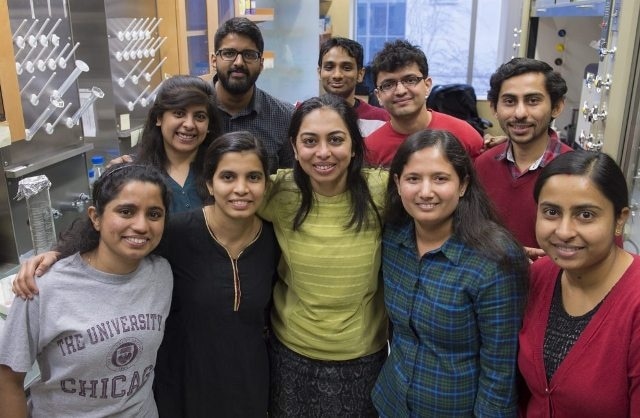Mar 28 2016
Some biochemistry laboratories fashion proteins into complex shapes, constructing the DNA nanotechnological equivalent of Baroque or Rococo architecture. Yamuna Krishnan, however, prefers structurally minimalist devices.
 Prof. Yamuna Krishnan transplanted most of her research group from India to the United States since joining the UChicago faculty in 2014.(Photo by Robert Kozloff)
Prof. Yamuna Krishnan transplanted most of her research group from India to the United States since joining the UChicago faculty in 2014.(Photo by Robert Kozloff)
“Our lab’s philosophy is one of minimalist design,” said Krishnan, professor of chemistry. “It borders on brutalist. Functional with zero bells and whistles. There are several labs that design DNA into wonderful shapes, but inside a living system, you need as little DNA as possible to get the job done.”
That job is to act as drug-delivery capsules or as biomedical diagnostic tools.
In 2011, Krishnan and her group, then at the National Centre for Biological Sciences in Bangalore, India, became the first to demonstrate the functioning of a DNA nanomachine inside a living organism. This nanomachine, called I-switch, measured subcellular pH with a high degree of accuracy. Since 2011, Krishnan and her team have developed a palette of pH sensors, each keyed to the pH of the target organelle.
Last summer, the team reported another achievement: the development of a DNA nanosensor that can measure the physiological concentration of chloride with a high degree of accuracy.
“Yamuna Krishnan is one of the leading practitioners of biologically oriented DNA nanotechnology,” said Nadrian Seeman, the father of the field and the Margaret and Herman Sokol Professor of Chemistry at New York University. “These types of intracellular sensors are unique to my knowledge, and represent a major advance for the field of DNA nanotechnology.”
CHLORIDE SENSOR
Chloride is the single most abundant, soluble, negatively charged molecule in the body. And yet until the Krishnan group introduced its chloride sensor—called Clensor—there was no effective and practical way to measure intracellular stores of chloride.
“What is especially interesting about this sensor is that it is completely pH independent,” Seeman said, a significant departure from Krishnan’s previous scheme. “She spent a number of years developing pH sensors that work intra-cellularly and provide a fluorescent signal as a consequence of a shift in pH.”
The ability to record chloride concentrations is important for many reasons. Chloride plays an important role in neurobiology, for example. But calcium and sodium—both positively charged ions—tend to grab most of the neurobiological glory because of their role in neuron excitation.
“But if you want your neuron to fire again, you have to bring it back to its normal state. You have to stop it firing,” Krishnan said. This is called “neuronal inhibition,” which chloride does.
“It’s important in order to reset your neuron for a second round of firing, otherwise we would all be able to use our brains only once,” she said.
Under normal circumstances, the transport of chloride ions helps the body produce thin, freely flowing mucus. But a genetic defect results in a life-threatening disease: cystic fibrosis. Clensor’s capacity to measure and visualize protein activity of molecules like the one related to cystic fibrosis transmembrane could lead to high-throughput assays to screen for chemicals that would restore normal functioning of the chloride channel.
NINE DISEASES
“One could use this to look at chloride ion channel activity in a variety of diseases,” Krishnan said. “Humans have nine chloride ion channels, and the mutation of each of these channels results in nine different diseases.” Among them are osteopetrosis, deafness, muscular dystrophy and Best’s macular dystrophy.
The pH-sensing capabilities of the I-switch, meanwhile, are important because cells contain multiple organelles that maintain specific values of acidity. Cells need these different microenvironments to carry out specialized chemical reactions.
“Each subcellular organelle has a specific resting value of acidity, and that acidity is crucial to its function,” Krishnan said. “When the pH is not the value that it’s meant to be, it results in a range of different diseases.”
There are 70 rare diseases called lysosomal storage disorders, which are progressive and often fatal. Each one—including Batten disease, Niemann-Pick disease, Pompe disease and Tay-Sachs disease—represents a different way a lysosome can go bad. She likened a defective lysosome to a garbage bin that never gets emptied.
“The lysosome is basically responsible for chewing up all the garbage and making sure it’s either reused or got rid of. It’s the most acidic organelle in the cell.” And that acidity is crucial for the degradation process.
Although there are 70 lysosomal storage diseases, small molecule drugs are available for only a few of them. These existing treatments—enzyme-replacement therapies—are expensive and are only palliative treatments. One goal of Krishnan’s group is to demonstrate the utility of their pH sensors to discover new biological insights into these diseases. Developing small molecule drugs—which are structurally simpler and easier to manufacture than traditional biological drugs—could help significantly.
“If we can do this for one or two lysosomal diseases, there’ll be hope for the other 68,” Krishnan said.